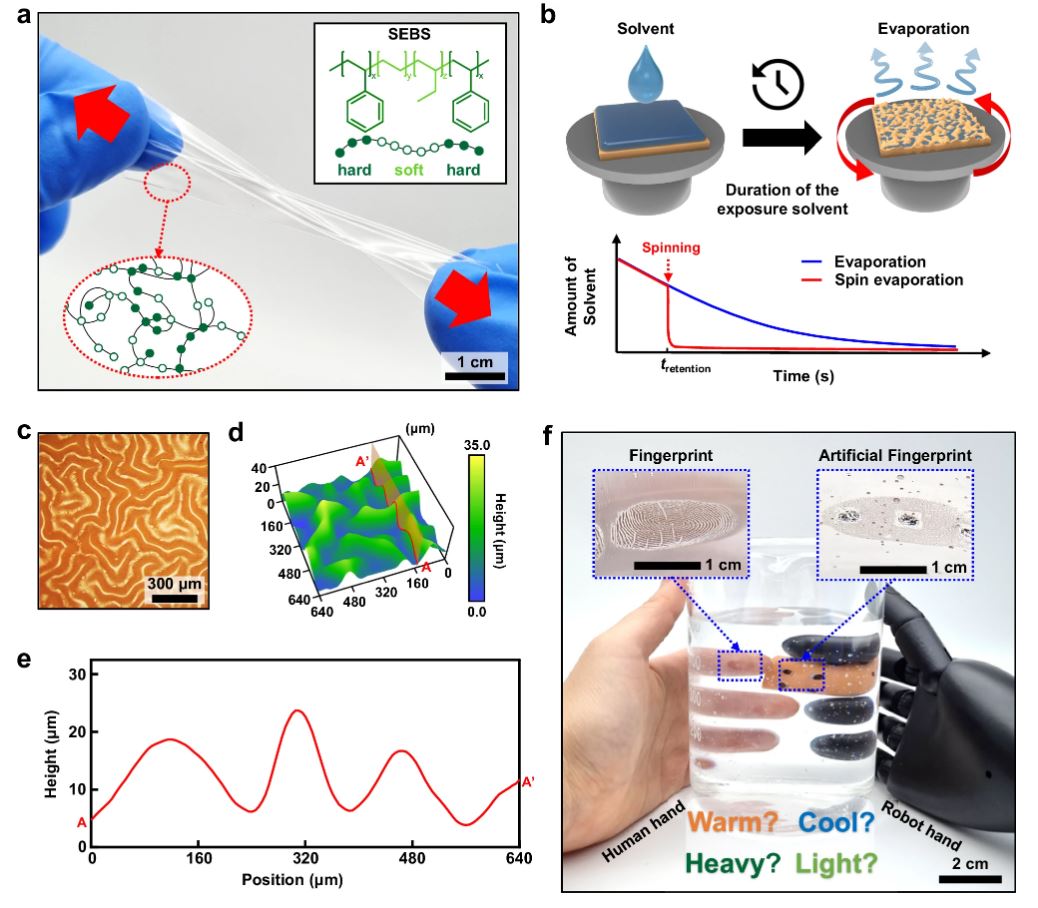Abstract
The likelihood of two human fingerprints being identical is extremely low-about 1 in 640 billion. Even identical twins, despite sharing the same genetic information, have unique fingerprints. A new technology now allows us to engrave these unique fingerprint patterns onto electronic skin, with the probability of matching an artificial fingerprint being 10²³² times lower than that of human fingerprints.
A research team, led by Professor Kyoseung Sim from the Department of Chemistry at UNIST has developed advanced electronic skin that features unique wrinkling patterns, surpassing even those of human fingerprints. This innovation may pave the way for a new era in which physical AI robots can possess unique fingerprint identification capabilities.
To be effective, electronic skin must incorporate sensors for tactile sensation while also maintaining flexibility. Thus, flexible organic materials are more suitable than rigid inorganic ones. Moreover, electronic skin meant for fingers must be capable of distinguishing between objects, making it challenging to create skin that possesses both functionality and unique fingerprint-like patterns.
Professor Sim's team has designed a method to easily engrave random wrinkling patterns on styrene-ethylene-butylene-styrene (SEBS) electronic skin. The technique involves chemically treating a flexible polymer to initially create the skin and then applying toluene solvent before spinning it rapidly. As the toluene evaporates, the skin's surface contracts to form these random wrinkles.
 Figure 1: SEBS wrinkling enabling identifiable artificial finger pad electronics. a Optical image and schematic of SEBS structure. b Schematic of spin evaporation. c-e Representative optical microscopy (c), confocal laser scan microscopy (d), and cross-sectional profile (e) of SEBS wrinkle. f Optical image of the human hand and identifiable artificial finger pad electronics.
Figure 1: SEBS wrinkling enabling identifiable artificial finger pad electronics. a Optical image and schematic of SEBS structure. b Schematic of spin evaporation. c-e Representative optical microscopy (c), confocal laser scan microscopy (d), and cross-sectional profile (e) of SEBS wrinkle. f Optical image of the human hand and identifiable artificial finger pad electronics.
The probability of this artificial fingerprint being reproduced in the exact same shape is merely 10⁻⁴³ based on a 1mm² area-an astounding figure that is 10²³² times lower than the probability for human fingerprints. When scaled up to the size of a human fingerprint, the likelihood of producing the same pattern approaches zero. Additionally, this electronic skin is resilient to physical impacts, heat, and humidity, allowing for the preservation of its fingerprint-like structure.
When implanted into a robotic hand, the developed electronic skin enables the robot to grasp objects similarly to humans, recognize surface textures, and differentiate between living beings. The research team has demonstrated a physical interaction where a robot equipped with temperature-sensing electronic skin avoids hot objects, mimicking human responses.
 Figure 2. Soft artificial finger pad. (a) Optical images of the soft artificial finger pad on robotic hand (left), freestanding artificial finger pad (middle), and optical microscopy image of artificial fingerprint (right). (b) Schematic exploded view of the fully soft artificial finger pad. c Stress-strain curves of components used.
Figure 2. Soft artificial finger pad. (a) Optical images of the soft artificial finger pad on robotic hand (left), freestanding artificial finger pad (middle), and optical microscopy image of artificial fingerprint (right). (b) Schematic exploded view of the fully soft artificial finger pad. c Stress-strain curves of components used.
"By employing a straightforward process, we have achieved a lower probability of creating identical patterns compared to actual fingerprints," noted Professor Sim. "This technology has broad potential applications in security and unique identification for future technologies, such as personalized electronic skin, soft robots with life-cycle management, and next-generation human-machine interfaces."
The study involved first authors Juyeong Lee and Haechan Park from the UNIST Department of Chemistry and was conducted in collaboration with Professor Zhengwei Li's team from the Department of Biomedical Engineering at the University of Houston in the United States of America.
This research was supported through the UBSI Research Fund of UNIST and the Young Researcher Support Program by the Ministry of Science and ICT (MSIT) and the National Research Foundation of Korea (NRF). The findings were published in the prestigious international journal, Nature Communications on March 5, 2025.
Journal Reference
Juyeong Lee, Haechan Park, Sehyun Kim, et al., "Irreproducible SEBS wrinkling based on spin evaporation enabling identifiable artificial finger pad electronics," Nat. Commun., (2025).






